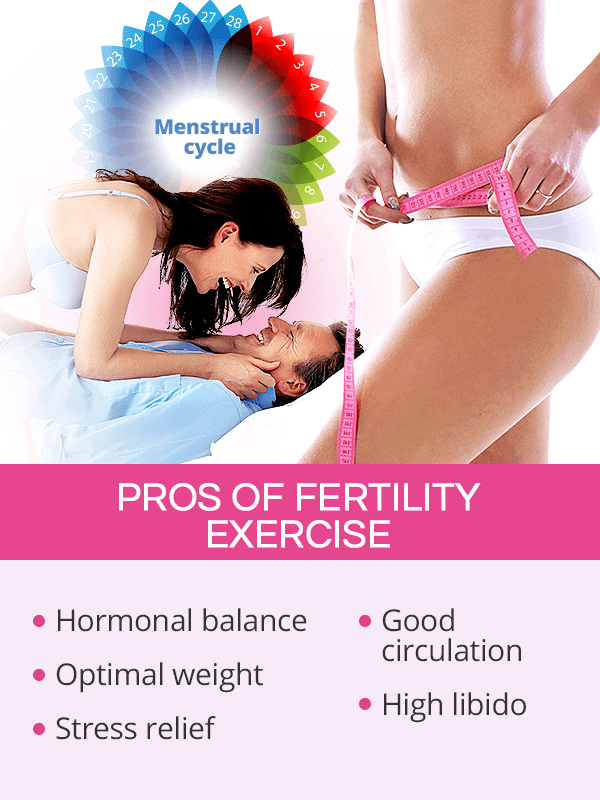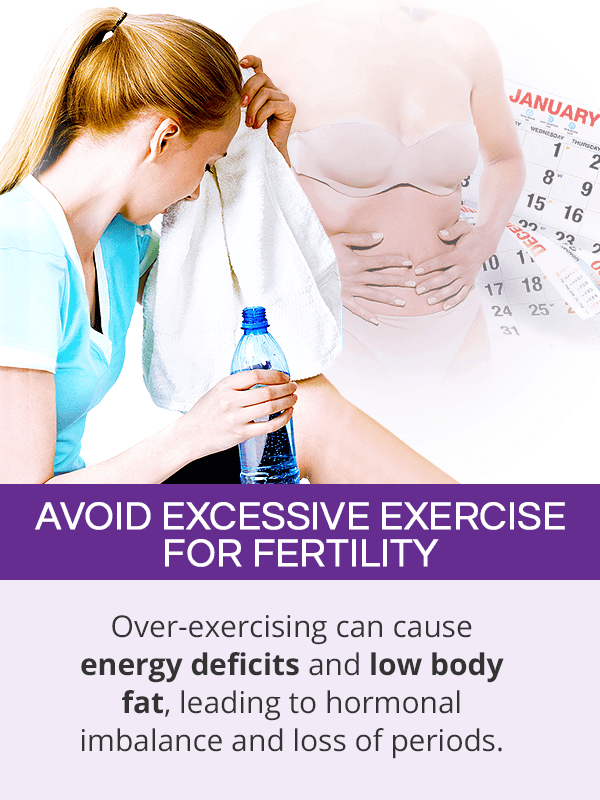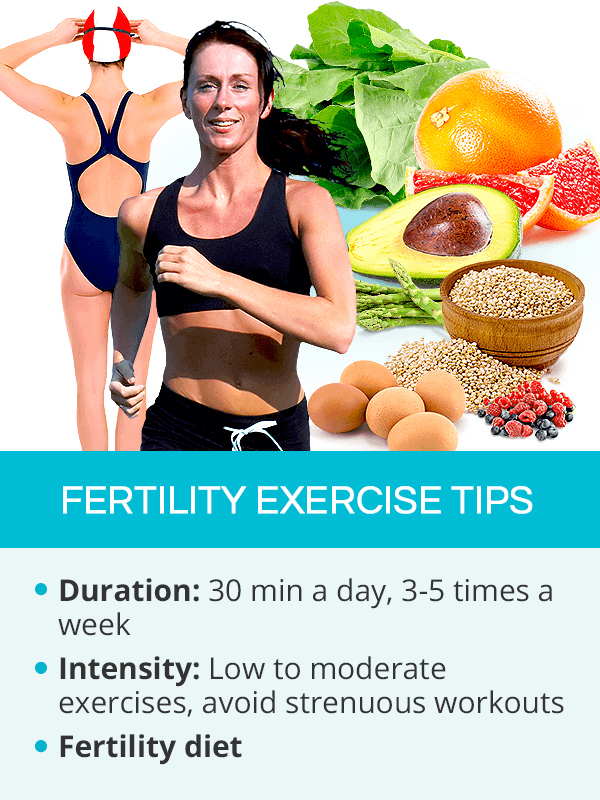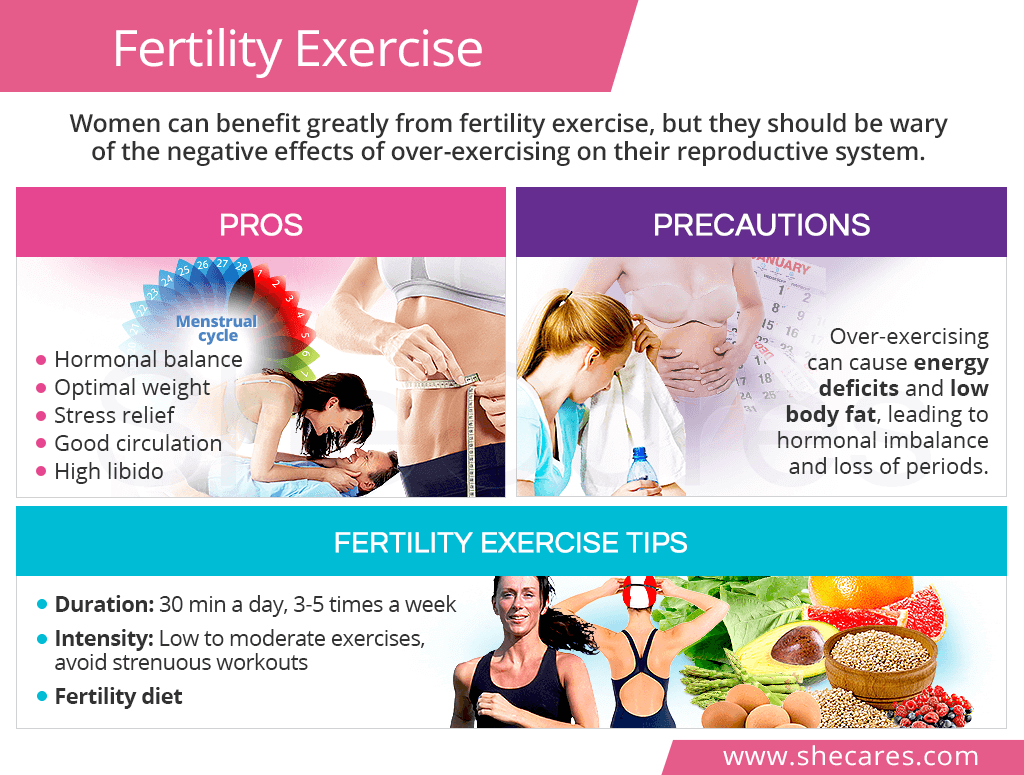Pros of Fertility Exercise

For prospective mothers, keeping up with exercise while trying to conceive can have the following benefits:
Hormonal Balance
Fertility problems are mainly caused by hormonal imbalance. Abnormally high estrogen deregulates the equilibrium of other hormones, preventing ovulation from occurring and reducing fertility. Regular physical activity has been found to stimulate the endocrine system to balance its hormone production and aid in normalizing estrogen levels to restore a woman's reproductive potential.
Weight Control
Obesity is one of the leading risk factors of infertility by disrupting the production of reproductive hormones and leading to insulin resistance, which - in turn - can deregulate menstruation and ovulation. Regular physical activity can help women safely achieve their optimal body mass index (BMI) to regulate their cycles and increase their chances of a healthy pregnancy.
Stress Relief
Prolonged stress leads to high levels of cortisol, the stress hormone, which can reduce fertility mainly by disrupting the communication between the brain and the ovaries to mature the eggs and release one on ovulation day. Exercising can decrease cortisol levels and stimulate the brain's release of endorphins, dopamine, serotonin, and norepinephrine, all of which are important in mood regulation and releasing stress and anxiety.
Blood Flow
Proper circulation helps nourish the reproductive organs, improve nutrient and hormone transport to them, and stimulate egg maturation in preparation for ovulation. Regular exercise naturally stretches the blood vessels connecting all organs, gradually making them stronger and more flexible, thus more nourished and efficient in distributing blood where it is needed.
High Libido
Having prime sexual desire is a must when trying to get pregnant. Studies have shown that exercise can boost one's libido and increase overall sexual satisfaction. When intercourse is rewarding, couples are more inclined to increase its frequency, which translates to higher chances of getting pregnant.
Overall Health
Exercise is one of the best ways to stay healthy as it can strengthen the heart, bones, and muscles; improve the brain and cognitive functions; relieve insomnia and fatigue; and prevent depression, among other benefits. When a woman's health is in check, she is more likely to have regular menses and optimal ovulation, both of which are indicators of good fertility.
Cons of Excessive Exercise

Despite numerous benefits of fertility exercise, exercising too much can have adverse effects on a woman's chances for pregnancy. There are two main disadvantages to excessive workouts:
Hormonal Imbalance
When a woman is losing more calories than she consumes from food, there is an energy deficit created in the body and an overproduction of certain hormones, such as beta endorphins. This, in turn, leads to a reduced release of progesterone and increased production of cortisol, which causes further hormonal imbalance of other key reproductive and thyroid hormones. As a result, women who engage in strenuous exercise often have irregular periods or stop having their periods at all, a condition called secondary amenorrhea. Without a menstrual cycle, the body is not ovulating, and pregnancy is not feasible.
Low Body Fat
To sustain healthy menstruation, the body needs adequate supplies of body fat, namely between 21-31% of total body weight. Women whose body fat falls below 10% are at a higher risk of altered reproductive functions due hormonal disruption. As a result, menstrual irregularities ensue, reducing their ability to conceive. Women with low body fat are also over 70% more likely to suffer from a miscarriage as the body does not have the means to sustain a pregnancy.
Fertility Exercise Tips

Understandably, the aforementioned findings might cause a great deal of confusion among women who want to boost their fertility with exercise.
Fortunately, the negative effects of working out on a woman's fertility are not permanent. They can be easily avoided or reversed with proper adjustments in the duration and intensity of one's workouts.
Duration: Keep it Short
For women who are planning to conceive, it is recommended to exercise for 30 minutes a day, 3 to 5 times a week. They should avoid working out every day and for longer than an hour at a time.
Women who are new to exercise are encouraged to start slowly with 10 to 15-minute workouts and gradually increase the duration and intensity. On the other hand, those who exercised extensively prior to starting their pregnancy preparations are advised to decrease the intensity of their routines so that they do not exceed the recommended duration.
Intensity: Opt for Low to Moderate Exercises
To sustain healthy menstrual cycles, women should by all means avoid strenuous exercises, including endurance training, heavy weight lifting, long-distance running, ballet, or Bikram yoga. The most effective fertility exercises alternate between low- to moderate-level cardio workouts with muscle strengthening. Some of the best fertility-boosting sports include:
- Light jogging
- Swimming
- Brisk walking
- Dancing
- Zumba
Fertility yoga, which combines exercise with meditation, is a popular alternative therapy for fertility among prospective mothers as it can boost fertility by increasing circulation to the reproductive organs, stimulating endocrine function and hormonal production, and promoting stress relief.
Don't Forget to Eat Right
For women who exercise while trying to conceive, proper nutrition is one of the most important components of the process. Following a well-balanced and wholesome fertility diet can help women avoid creating energy deficits and keep their hormones in check.
Key Takeaways
As women begin preparing to get pregnant, they often automatically make a plan to eat better and exercise more to boost their chances of conceiving. Regular fertility exercise promotes hormonal balance, optimal weight, stress-relief, or high libido, all of which can ensure regular menstrual cycles and ripe fertility. Ironically, exercising too much can decrease female fertility by disrupting reproductive hormones and reducing body fat percentage enough to stop monthly periods. Luckily, by working out for 30 minutes a day, 3-5 times a week and opting for low- to moderate-level routines, such as light jogging, swimming, or brisk walking, women can reap the benefits from fertility exercises as they make a step towards motherhood.
Sources
- Breast Cancer Research. (2015). Effect of physical activity on sex hormones in women: A systematic review and meta-analysis of randomized controlled trials. Retrieved December 12, 2018 from https://www.ncbi.nlm.nih.gov/pubmed/26541144
- Human Reproduction. (2010). High prevalence of subtle and severe menstrual disturbances in exercising women: confirmation using daily hormone measures. Retrieved December 12, 2018 from https://www.ncbi.nlm.nih.gov/pubmed/19945961
- Exercise and Human Reproduction. (2016). Impact of Physical Activity and Exercise on Female Reproductive Potential. Retrieved December 12, 2018 from https://link.springer.com/chapter/10.1007%2F978-1-4939-3402-7_11
- The Physician Sports Medicine. (1993). Does Exercise Enhance Sexuality? Retrieved December 12, 2018 from https://www.ncbi.nlm.nih.gov/pubmed/27439052


